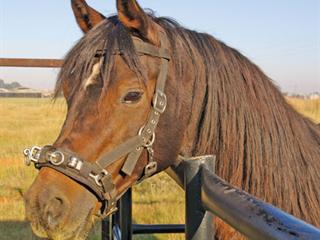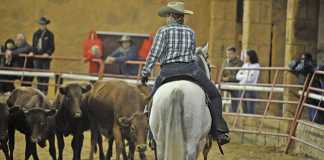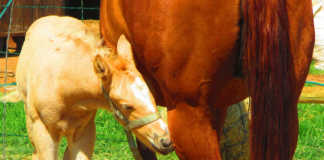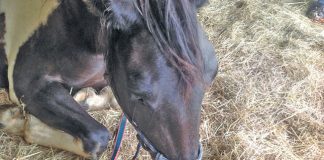
Before discussing long lining, remember that the horse that is started with kindness and consideration will give kindness and consideration back a hundred times over. If you have the privilege of owning a mare and are able to breed your own foal, you have an advantage. Never show your foal that you can’t be trusted.
If you start long lining with a two-year-old, you can develop an animal that’s well-muscled throughout the hindquarter, and one that’s developed the fluid balance needed to move forward under saddle when the time comes. Once your foal is happy to walk on a lead, you can start to do join up. Then you desensitise your young horse.
Start by placing a very long lead rein on the end of a leather head collar. Allow the lead rope to go all over your horse. Take your time and make sure your horse submits to all the contact with the lead rope. Start by letting the youngster smell the rope, then gradually place the rope over its neck, then withers, then back, hindquarters and feet. Once it’s comfortable with the rope all over its body you’re ready to start backing your youngster.
Backing
The moment you put a rider on its back, the young horse will have to learn to balance itself with the new weight. So it’s essential your horse is fully trained on long lines before you put a weight on its back. If you’ve bought an older horse and it’s unpredictable, then it’s wise to go back to basics. This means starting with desensitising. A horse that bites and kicks feels threatened and often these protective measures become nasty habits.
In my opinion, a horse that runs away with its rider is running in fear. Often people keep placing a more severe bit in this horse’s mouth until it submits, or is sold. Many such horses end up in my stable yard. And within a few months they’re shown that humans can be taught to speak ‘horse’.
Flexibility
Long lining is a technique used to teach a horse how to steer, stop, bend and give, to instil confidence in a frightened horse, to prepare a horse to drive, to teach new steps in a training programme or to rehabilitate an injured horse. Unlike lungeing, when you long line you have the advantage of flexibility to ground drive, double lunge and work in hand.
With long lining you have two long reins attached to either side of your horse’s mouth, via a lunge cavesson or bit. This gives you the ability to influence the inside/outside contact and bend. It also allows you to release the contact so the result is a more elastic connection.
Your horse has the benefit of trying out new movements without having to balance the weight of the rider. Safety is very important. Your horse must be very comfortable with the rope, must understand simple lunge commands such as “halt”, “trot”, “canter” and “stop” and must have good ground manners. You’ll be working very close to its hindquarters and a kick could do serious harm.
You’ll need: one pair of long lines; lunge cavesson or halter; surcingle, saddle pad or roller ground poles; and blocks.
Next time I’ll go through the basics step by step. For now, practise desensitising your horse and getting it to walk, halt, trot and turn on the hindquarter on voice command.
Contact Kim Dyson on 082 888 6511 or at [email protected]. Please state ‘Horse therapy’ in the subject line of your email.













